AZ-204 Preparation Details
Preparing for the AZ-204 Developing Solutions for Microsoft Azure exam? Don’t know where to start? This post is the AZ-204 Certificate Study Guide (with links to each exam objective).
I have curated a list of articles from Microsoft documentation for each objective of the AZ-204 exam. Please share the post within your circles so it helps them to prepare for the exam.
Exam Voucher for AZ-204 with 1 Retake
Get 40% OFF with the combo
AZ-204 Developing Solutions for Azure Course
| Skylines Academy | NEW!: Microsoft Azure Developer Certification |
| Pluralsight | Developing Solutions for Microsoft Azure |
| Udemy | Developer Exam Prep for Azure Certification |
AZ-204 Azure Developer Practice Tests & Labs
| Whizlabs Exam Questions | 165 Practice questions & [Online Course] |
| Udemy Practice Tests | Developing Solutions for Azure Practice Test |
Azure Developer Learning Materials (AZ-204)
| Udacity (Nanodegree) | Become a Developer for Microsoft Azure |
| Amazon e-book (PDF) | Azure Developer Exam Reference Book |
| Coursera (specialization) | Azure Developer Associate Test prep |
Looking for AZ-204 Dumps? Read This!
Using az-204 exam dumps can get you permanently banned from taking any future Microsoft certificate exam. Read the FAQ page for more information. However, I strongly suggest you validate your understanding with practice questions.
Check out all the other Azure certificate study guides
Full Disclosure: Some of the links in this post are affiliate links. I receive a commission when you purchase through them.
Develop Azure Compute Solutions (25-30%)
Implement IaaS solutions
Provision virtual machines (VMs)
Create a Windows VM in Azure with PowerShell
Configure, validate, and deploy ARM templates
Create & deploy ARM templates by using the Azure portal
Configure container images for solutions
Create a container image for deployment to Azure Container Instances
Test your knowledge on Azure Compute Solutions
Q] You have to deploy a microservice-based application to the Azure Kubernetes cluster. The solution has the following requirements:
- Reverse proxy capabilities
- The ability to configure traffic routing, and,
- Termination of TLS with a custom certificate
Which of the following would you use to implement a single public IP endpoint to route traffic to multiple microservices?
- Helm
- Brigade
- Kubectl
- Ingress Controller
- Virtual Kubelet
Explanation: First, you need to know that Ingress is an object that manages external access to services in a cluster.
One of the main reasons to use an ingress controller is that by using a single IP address, you can route traffic to multiple services in a Kubernetes cluster.
The documentation mentions that an ingress controller is a piece of software that provides reverse proxy, configurable traffic routing, and TLS termination for Kubernetes services, all of which are a requirement in the question.

So, option 1 is the correct choice.
Reference Link: Create an ingress controller
This question is part of the free AZ-204 Whizlabs practice test. My detailed explanation (with demo) is given on my YouTube channel as well!
Publish an image to the Azure Container Registry
Push image to Azure Container Registry
Run containers by using Azure Container Instance
Deploy a container application to Azure Container Instances
Create Azure App Service Web Apps
Create an Azure App Service Web App
Create an ASP.NET Core web app in Azure
Test your knowledge on Azure App Service
Q] A company has a web application deployed using the Azure Web App service. The current service plan being used is D1.
It needs to ensure that the application infrastructure can automatically scale when the CPU load reaches 85%. You also have to ensure costs are minimized.
Which of the following steps would you implement to achieve the requirements? Choose 4 answers from the options given below:
- Enable autoscaling on the Web application.
- Configure a scale condition.
- Configure the web application to use the Standard App Service Plan.
- Configure the web application to use the Premium App Service Plan.
- Add a scale rule.
Explanation: Well, the app service plan D1 is only for the shared infrastructure and so contains only a limited number of features. For the D1 plan, autoscaling is not supported. So, the application cannot scale automatically when the CPU load reaches 85%.
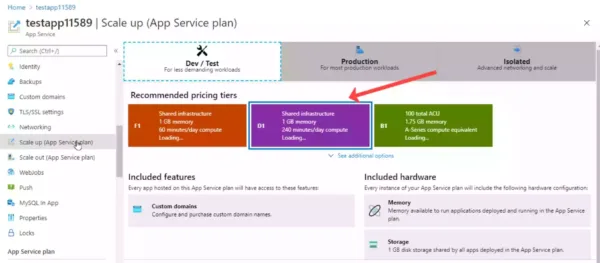
To enable autoscaling, you need to upgrade the app service plan tier. Plans like B1, B2, and B3 enable you to scale manually but not automatically.
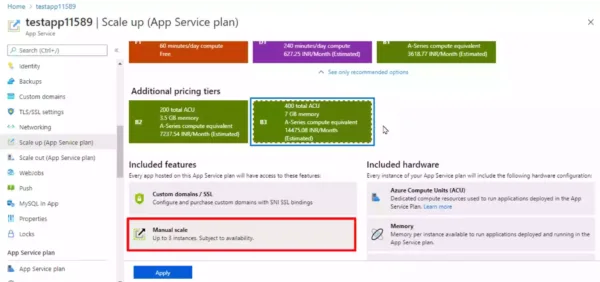
Autoscaling is only available for the standard and the premium plans.
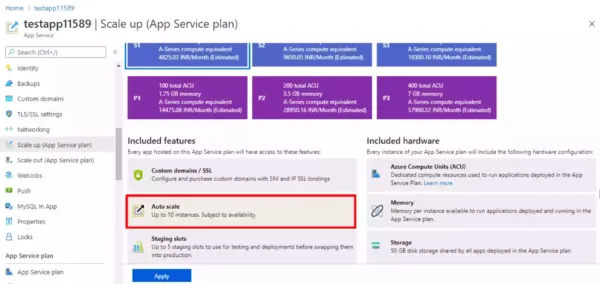
So, these are the following steps to implement:
- First, we need to configure the web application to use the standard app service plan. Note that the premium app service plan works too, but since we need to ensure that costs are minimized too, option 4 is incorrect.
- And, since we need to select a total of 4 options, all the other 3 options must be selected to achieve the requirement.
Reference Link: App Service plans overview
Scale-up an app in App Service
This question is part of the free AZ-204 Whizlabs practice test. My detailed explanation (with demo) is given on my YouTube channel as well!
Enable diagnostics logging
Enable diagnostics logging for apps in Azure App Service
Deploy code to a web app
Deploy your app to Azure App Service with a ZIP or WAR file
Configure web app settings including SSL, API, and connection strings
Test your knowledge on Azure App Service
Q] You deploy a web application to Azure with App Service on Linux. You then publish a custom docker image to the Azure Web App.
Suppose you need to access the console logs generated from the container in real-time. Which of the following would go into Slot1 in this Azure CLI script?
az webapp log Slot1 --name testapp --resource-group test-rg Slot2 filesystem
az Slot3 log Slot4 --name testapp --resource-group test-rg
- config
- download
- show
- tail
Explanation: To configure logging, we use the command az webapp log config. Option 1 is the correct choice.
You can easily ignore the other options as it is evident from their names that:
download downloads a web app’s Log history as a zip file,
show gets the details of a web app’s logging configuration and,
tail starts live log tracing for a web app.
Reference Link: az webapp log config
This question is part of the free Whizlabs practice test. My detailed explanation (with demo) is given on my YouTube channel as well!
Implement autoscaling rules, including scheduled autoscaling, and autoscaling by operational or system metrics
Azure App Service Autoscaling rules
Scheduled Autoscaling & scaling by operational or system metrics
Also, review the common autoscale patterns
Implement Azure Functions
Create and deploy Azure Functions apps
Deploy a function app to Azure Functions
Implement input and output bindings for a function
Azure Functions triggers and bindings concepts
Test your knowledge on Azure Function Bindings
Q] You develop an Azure Function that performs the following activities:
- Read messages from an Azure Storage Queue, and,
- Process the messages and add entities to Azure Table Storage
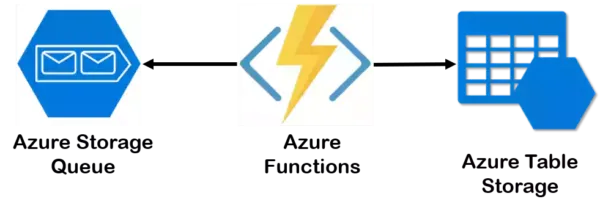
You have to define the correct bindings in this function.json file.
{
"bindings": [
{
"type": "queueTrigger",
"direction": slot1 ,
"name": "my-orders",
"queueName": "queue-items",
"connection": "STORAGE_APP_SETTING"
},
{
"type": "table",
"direction": slot2 ,
"name": slot3 ,
"tableName": "out-table",
"connection": "TABLE_APP_SETTING"
}
]
}
Which of the following would go into Slot 1?
- “in”
- “out”
- “trigger”
- “$return”
Explanation: Since we need to read messages from the Azure Storage Queue, an Azure Queue Storage trigger is defined as the first element in the binding array.
And since we need to process and add entities to Azure table storage, the second element in the array defines the Azure Table Storage output binding.
So, the binding direction will be out (slot 2) for the 2nd item in the array since it is an output binding. And the binding direction for triggers (slot 1) is always in.
Option 1 is the correct choice.
Reference Link: Azure Functions trigger and binding
Binding direction in Azure Functions
This question is part of the free AZ-204 Whizlabs practice test. My detailed explanation (with demo) is given on my YouTube channel as well!
Implement function triggers by using data operations, timers, and webhooks
Timer trigger for Azure Functions
Create an Azure function triggered by a webhook
Implement Azure Durable Functions
Create Durable Functions using the Azure portal
Implement custom handlers
Azure Functions custom handlers
Develop for Azure Storage (15-20%)
Develop Solutions That Use Cosmos DB Storage
Select the appropriate API and SDK for a solution
Choose the appropriate API for Azure Cosmos DB
Implement partitioning schemes and partition keys
Model & partition data on Azure Cosmos DB using a real-world example
Partitioning and horizontal scaling in Azure Cosmos DB
Deep Dive into Azure Cosmos Partition Keys
Perform operations on data and Cosmos DB containers
Insert and query data in your Azure Cosmos DB database
Set the appropriate consistency level for operations
Choose the right consistency level
Manage change feed notifications
Change feed in Azure Cosmos DB
Change Feed – Unsung hero of Azure Cosmos DB
Develop Solutions That Use Blob Storage
Move items in blob storage between storage accounts or containers
Moving Azure storage blobs using CLI
Test your knowledge on Azure Storage Account
Q] You have to implement the azcopy tool to copy objects from a local folder named ‘Contoso’ in the ‘D’ drive to a container named ‘demo’ in a storage account.
And, the command azcopy is given which copies all the objects in the local folder.
azcopy copy slot1 slot2/?sv=2018-03-28&
amp;ss=bjqt&srt=sco&sp=rwddgcup&se=
2019-05-01T05:01:17Z&st=2019-04-30T
21:01:17Z&spr=https&sig=MGCXiyEzbtttk
r3ewJIh2AR8KrghSy1DGM9ovN734bQF4%
3D" --recursive=false
Which of the following would go into Slot2?
- contoso.blob.core.windows.net/demo
- contoso.blob.windows.net/demo
- D:\contoso
- contoso
Explanation: To copy objects with the azcopy tool, use the azcopy command with the copy keyword. Then comes the local directory from where the objects need to be copied. Next comes the destination URL of the target container in the storage account.
Clearly options 3 and 4 are incorrect. Option a is the correct answer as the correct URL for a storage account will be in the format <name>.blob.core.windows.net. And, demo is the name of the container.
The characters that you see after the container name are for the SAS token.
Reference Link: Using a SAS token
This question is part of the free Whizlabs practice test. My detailed explanation (with demo) is given on my YouTube channel as well!
Set and retrieve properties and metadata
Setting properties & metadata during the import process
Perform operations on data by using the appropriate SDK
Azure Blob storage client library v12 for .NET
Implement storage policies, and data archiving and retention
Manage immutability policies for Blob storage
Amazon link (affiliate)
Implement Azure Security (20-25%)
Implement User Authentication and Authorization
Authenticate and authorize users by using the Microsoft Identity platform
Authentication with the Microsoft identity platform endpoint
Microsoft identity platform & OAuth 2.0 authorization code flow
Authenticate and authorize users and apps by using Azure Active Directory
Test your knowledge on Azure Active Directory
Q] You build a web application that’s deployed to Azure. The application would not allow anonymous access and the authentication would be carried out via Azure AD. Further, the application needs to abide by the following requirements:
- Users must be able to log into the web application using their Azure AD credentials
- The personalization of the web application must be based on the membership in Active Directory groups
{
'appId' : 'ad1403a-dfb-48d03-b15-e622s3le31'
slot1 : 'all'
slot2 : true
}
You have to configure the application manifest file. Which of the following would go into Slot2?
- allowPublicClient
- oauth2Permissions
- requiredResourceAccess
- oauth2AllowImplicitFlow
Explanation: First, see the below application manifest file which sometimes you would edit to configure the attributes of an application in Azure Active Directory.
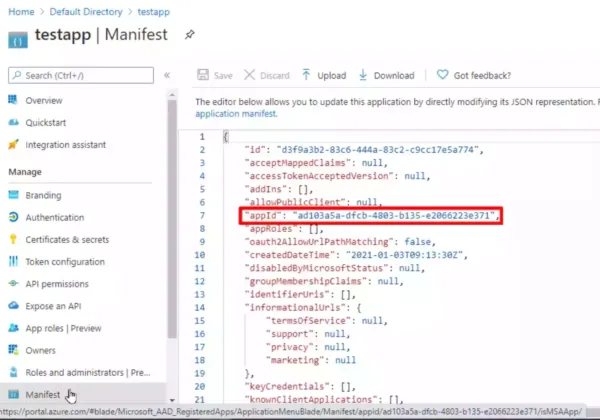
All the applications contain something called appID which is nothing but the application ID or the Client ID.
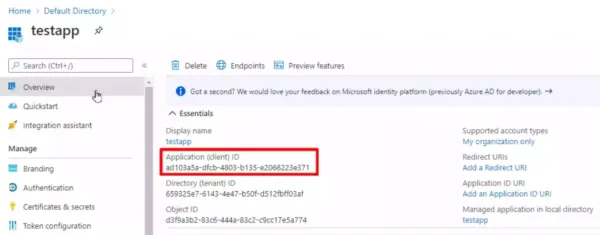
From the question, it is evident that the attribute (in slot2) will have a value of type Boolean.
Now, to meet the requirements in the question, you would set the value of the attribute oauth2AllowImplicitFlow to True.
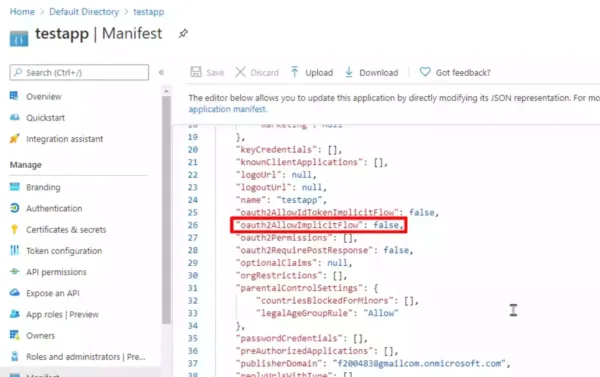
This attribute specifies whether a web app can request OAuth2.0 implicit flow access tokens for browser-based apps, like single-page apps.
So, option 4 perfectly fits what’s asked in the question.
Options oauth2Permissions and requiredResourceAccess represent a value of type Collections so you can easily ignore them.

Reference Link: Azure Active Directory app manifest
requiredResourceAccess attribute
This question is part of the free AZ-204 Whizlabs practice test. My detailed explanation (with demo) is given on my YouTube channel as well!
Create and implement shared access signatures
Grant limited access to Azure Storage resources using SAS
Implement Secure Cloud Solutions
Secure app configuration data by using App Configuration Azure Key Vault
Use Key Vault references in an ASP.NET Core app
Centralized app configuration and security
Develop code that uses keys, secrets, and certificates stored in Azure Key Vault
Keys
Set and retrieve a key from Azure Key Vault using PowerShell
Azure Key Vault key client library for .NET (SDK v4)
Secrets
Set and retrieve a secret from Key Vault using PowerShell
Azure Key Vault secret client library for .NET (SDK v4)
Certificates
Set and retrieve a certificate from Azure Key Vault
Azure Key Vault certificate client library for .NET (SDK v4)
Implement solutions that interact with Microsoft Graph
Test your knowledge of Microsoft Graph API
Q] You develop an ASP.Net Core application that works with blobs in an Azure storage account. The application authenticates via Azure AD credentials.

Role-based access has been implemented on the containers that contain the blobs. These roles have been assigned to the users.
You have to configure the application so that the user’s permissions can be used with the Azure Blob containers.
Which of the following would you use as the Permission for the Microsoft Graph API?
- User.Read
- User.Write
- client_id
- user_impersonation
Explanation: First, log in to the Azure portal and create a new app registration in the Azure Active Directory for the ASP.Net Core application.
Click ‘App registrations’ and then click ‘New registration.’ Enter a name for your app and then click ‘Register’ to create the app.
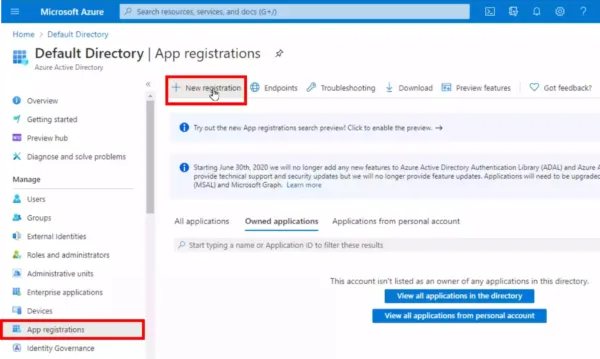
If you check the API permissions for the app, by default, the registered Azure AD application has access to the Microsoft Graph API.
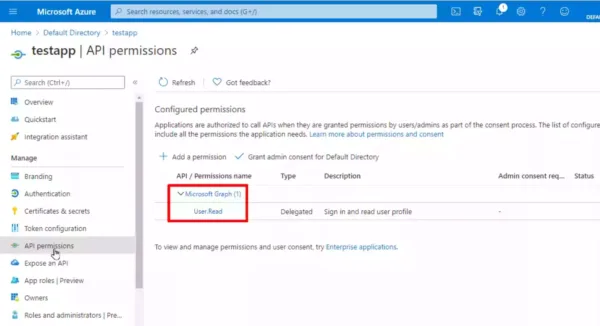
And the permission used by the app for accessing Microsoft Graph API is User.Read. So, option 1 is the right choice.
This question is part of the free AZ-204 Whizlabs practice test. My detailed explanation (with demo) is given on my YouTube channel as well!
Monitor, Troubleshoot, and Optimize Azure Solutions (15-20%)
Integrate Caching and Content Delivery within Solutions
Configure cache and expiration policies
Configure cache and expiration policy for Azure CDNs
Configure cache and expiration policies for Azure Redis Cache
Setting an expiration value on keys
How to configure Azure Cache for Redis
Implement secure and optimized application cache patterns including data sizing, connections, encryption, and expiration
Common cache patterns with Azure Redis Cache
Instrument Solutions to Support Monitoring and Logging
Configure an app or service to use Application Insights
Application Insights for ASP.NET Core applications
Configure Application Insights for your ASP.NET website
Application Insights for .NET console applications
Test your knowledge on Azure Application Insights
Q] A developer needs to enable the Application Insights Profiler for Azure Web App. Which of the following feature is a prerequisite to enable the Profiler?
- CORS configuration
- Always On setting
- Enable Identity
- Enable Custom domains
Explanation: Azure Application Insights Profiler provides performance traces for applications that are running in production in Azure.
Enabling Identity is part of Azure Active Directory and is not related to Application Insights Profiler.
Custom domains are a feature to access any Azure URI by a different or a customized URI. Hence this is not related to Application Insights Profiler.
Cross-origin resource sharing (or CORS) defines a way for web applications in 1 domain to interact with resources in another domain. CORS will not help in enabling Application Insights Profiler.
To enable Application Insights Profiler for a web App, the correct prerequisite is to enable ‘Always On.’
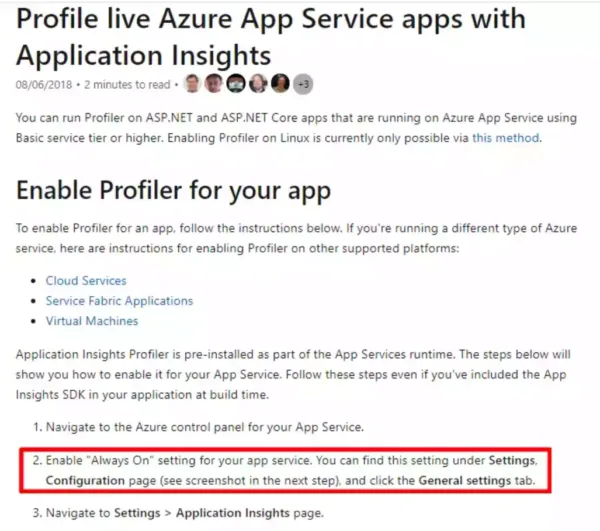
This is required because if a web app is idle for too long, Azure App Service unloads the website, and it only loads the website again when the traffic returns. By enabling ‘Always On’, you keep the Web App up and running all the time.
Reference Link: Profile live Azure App Service apps with Application Insights
This question is part of the free AZ-204 Whizlabs practice test. My detailed explanation (with demo) is given on my YouTube channel as well!
Analyze and troubleshoot solutions by using Azure Monitor
Troubleshoot solutions by using Azure Monitor
Troubleshoot an App Service app with Azure Monitor
Implement Application Insights web tests and alerts
Creating an Application Insights web test & alert programmatically
Connect to and Consume Azure services and Third-party Services (15-20%)
Implement API Management
Create an APIM instance
Creating Azure API Management instance using the Azure portal
Configure authentication for APIs
Secure APIs using client certificates in APIM
Define policies for APIs
How to set or edit Azure APIM policies
Develop Event-based Solutions
Implement solutions that use Azure Event Grid
Automate resizing uploaded images using Event Grid
Implement solutions that use Azure Notification Hubs
Send notifications to UWP apps using Azure Notification Hubs
Implement solutions that use Azure Event Hub
Visualize data anomalies in real-time events in Azure Event Hubs
Test your knowledge on Azure Event Hubs
Q] A company is building a traffic monitoring system. The system monitors the traffic along 4 highways and is responsible for producing a time series-based report for each highway.
The traffic sensors on each highway have been configured to send their data to Azure Event Hubs. The data from Event Hubs is then consumed by three departments. Each department makes use of an Azure Web App to display the data.
You have to implement the Azure Event Hub instance and ensure that data throughput is maximized and latency is minimized.
Which of the following would you use as the partition key?
- Highway
- Department
- Timestamp
- Datestamp
Explanation: The scenario in the question is best understood with the help of the diagram below:
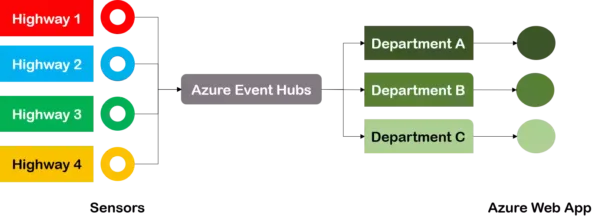
Since the data comes in for each highway, the highway represented by probably a highway number would be ideal for the partition key.
The other options are incorrect since they would not provide ideal values for the distribution of data across the partitions.
Reference Link: Partitions in Event Hub
This question is part of the free AZ-204 Whizlabs practice test. My detailed explanation (with demo) is given on my YouTube channel as well!
Import OpenAPI definitions
Import an OpenAPI specification
Import and publish your first API
API import restrictions & known issues
Develop Message-based Solutions
Implement solutions that use Azure Service Bus
Azure PowerShell to create a Service Bus namespace & a queue
Test your knowledge of Azure Service Bus
Q] You develop an application that makes use of Azure Service Bus. You create filters based on different types of subscribers that would subscribe to the topic.
Which of the following would you use as the filter condition for the requirement?
“Subscribers should be able to receive all messages being sent to the topic”
- Boolean filters
- Primary filters
- SQL filters
- Correlation filters
Explanation: Well, Azure Service Bus supports 3 different filter conditions: They are:
- Boolean filters
- SQL filters, and,
- Correlation filters.
Correlation filters have a set of conditions that are matched against the arriving messages.
SQL filter holds a SQL-like conditional expression that’s evaluated against the incoming messages.
Boolean filters cause either all or none of the arriving messages to be selected for the subscription.
Since the question mentions that we need to receive all messages sent to the topic, a Boolean filter would be more suitable.
Option 1 is the correct choice
Reference Link: Azure Service Bus topic filters
This question is part of the free AZ-204 Whizlabs practice test. My detailed explanation (with demo) is given on my YouTube channel as well!
Implement solutions that use Azure Queue Storage queues
Work with Azure storage queues in .NET
This brings us to the end of the AZ-204 Developing Solutions For Microsoft Azure Study Guide.
What do you think? Let me know in the comments section if I have missed out on anything. Also, I love to hear from you about how your preparation is going on!
In case you are preparing for other Azure certification exams, check out the Azure study guide for those exams.
Follow Me to Receive Updates on AZ-204 Exam
Want to be notified as soon as I post? Subscribe to the RSS feed / leave your email address in the subscribe section. Share the article to your social networks with the below links so it can benefit others.





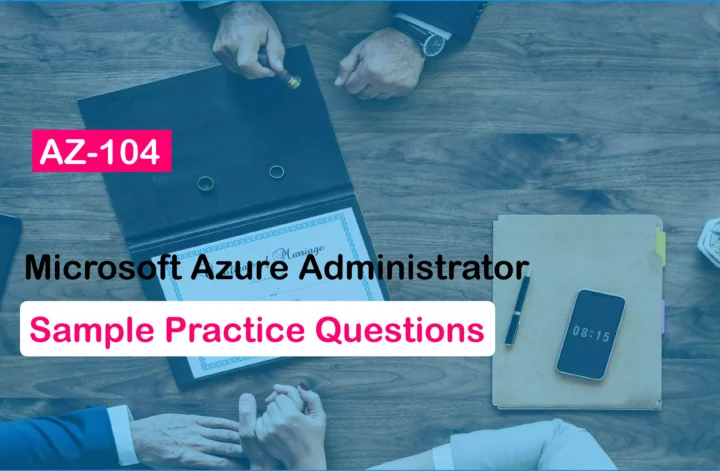

49 Comments
Hi, can you provide links for practice test
Hi Ravi sir,
Thank you for writing such an amazing blog. I have some additional queries
1) As a javascript developer, can I give this exam?
2) Can I host a MERN full-stack app on Azure?
Hi Ravikiran,
I am planning to write AZ 204 , I am preparing based on the links that you have mentioned.
COuld you please tell me if if they are asking labs currently , and should we learn all the commands in powershell that we use here . FOr example , VM creation, front door cache setting , and so on.
Kindly let me know .
Hi Ravi,
I am planning to write AZ204 . I have completed the AZ fundamentals certification. I would like to know if they ask us to write code during the exam. will there be labs? or what is the format of the exam ?
Hello Ranjitha,
You will be required to fill in the code blanks. No code required
Hi RaviKrian,
Thank you so much for detailed information.
I am looking for AZ-204 certification, I am a beginner for azure.
I am interested in Pluralsight learning, so when I am searching your link(Developing Solutions for Microsoft Azure (AZ-203)) for pulralsight I am getting 74 results.
So All 74, I need to follow right to get certified AAZ-204.
Kindly suggest me.
Hi Ravi,
My self Rakesh senior developer in Microsoft Technologies. I am looking for AZ-204 certification learning materials. Let me know the best approach to learn and do labs.
Hello Rakesh,
labs are available in GitHub, and for the course pick any from LinkedIn or Udemy
Verify understanding with PT, and get an Azure sub
Hi Ravi, thank you for this! do you have any books that you can recommend for this exam
It is a new exam, so I doubt there are any books out there
Thank you very much Ravi for this guide. Please if you aware, let me know whether AZ-204 exam includes lab or only multi choice questions.
Hello Jasmine, Generally they have labs, but these days labs are not tested.
Thank you Ravi, I have passed the exam successfully ?
Ravi, Jasmine,
I just started preparing for AZ 204 after completing AZ 900. New to cloud and experienced in Python.
However the MS learning path uses C# & Powershell throughout the course. Please let me know if the exam will be oriented towards any programming language/commands? Do we need to have in-depth C# or Powershell knowledge OR will a high level understanding of commands/scripts be sufficient.
TIA!
Hello Nikhil,
A high-level understanding of PowerShell commands is sufficient. There is a pattern to those PS commands that you can easily master.
Please check this documentation
https://docs.microsoft.com/en-us/powershell/azure/get-started-azureps?view=azps-4.5.0#find-commands
Hi Ravi, i passed AZ 204 today and really it was a tough one. Your pointers helped a looot 🙂 Being a QA and got thru this exam feels good 🙂
That’s awesome Kavitha. Congrats. What’s next on your learning journey?
Configure Just-in-time access to a VM: This does not seem to be part of AZ-204 or AZ-203, can you confirm?
VM for remote access is mentioned. I think they imply JIT
Is that book “Exam Ref AZ-203 Developing Solutions for Microsoft Azure” by Santiago Fernández Muñoz still useful when we are preparing for AZ-204? I read its contents, they are similar, and it gives some solid background in terms of concepts and understandings. Do you recommend we go through the above book to prepare for AZ-204? Thanks.
Yea, if you are a bookworm, that book will be a useful guide, but I doubt it is updated for az-204
It seems to be a very complete guide for those preparing for AZ-204 Exam, thanks for the efforts to compile all those information into one page. I am preparing for AZ-204, and will follow your links closely.
Hi Ravi,
Is whizlab or udemy considered braindump?
Hi Ravi,
I recently completed AZ-900 Fundamentals and looking forward to start preparing for AZ-204. And as i am from mainframe background with 10+ yrs exp, is it necessary to learn any other programming language ?
Well, you don’t have to…But trying laying your hands on Azure and developing some solutions with CLI, SDKs & other APIs before you appear for the exam
Hello Ravikiran, Thank you for details. I have 14 years of development exp but no Azure exp. Should going to through linkedin or pluralsight courses will be enough for me to pass the exam?
Hello Ravi,
I am a QA person with development knowledge and planning to write az 204 exam b this month end. i started following your blog and kicked off with preparation. Any other suggestions on d’s and dont’s will really help me please?
Awesome list of resources! Thank you for compiling this list. I am curious, do you know if the exam focuses more on Powershell vs Azure CLI commands?
Higher emphasis on PowerShell
Hi, Thanks alot for the details of the exam.
Question: I am preparing to take the Azure 204 exam. What process/Exam learning guides would you recommend out of the above?
Course – Pluralsight/LinkedIn
Practice Test – Whizlabs
Wow this is amazing! This will really save me a lot of time
Hello Ravikiran,
thanks for informative post. I have a question.
I heard that Microsoft removed hands-on-lab part from the AZ exams.
Is it still like that? Or lab section came back?
If there is a lab section in the exam, how can we study for it? I use generally Portal and I don’t know Azure-CLI. Should I memorize all the commands?
Thanks and regards.
Hi Mustafa,
It is like that currently. But it may change soon. The best thing is not to think about that and be prepared for everything.
You don’t need to memorize the commands. I suggest you start writing commands to create resources. After a while, you will easily figure out the pattern of those commands. That should be enough for the exam.
Hi Ravikiran,
Thank you a lot for your post, it is fantastic and very useful.
Are all question on Whizlabs genuine (i.e. no brain dumps)?
Thank you
Alberto
Thanks, Alberto.
Yea Whizlabs is not brain dumps
Hi Ravikiran,
Thank you for your answer,
Will AKS be part of the exam or will it only focus on Azure Container Instances?
Incidentally, I noticed in your links above there are references only on AKS?
Kind regards,
Alberto
Yea, AKS is not in objectives. Probably confused with az-203
Thanks for pointing out. I updated the exam resources
Thank you again, your article really saved me a lot of time.
Welcome
Hi, I want to do the AZ-203 or AZ-204 Exam. Can you please email me back with your contact so that i can touch base with you.
Please contact via the contact form